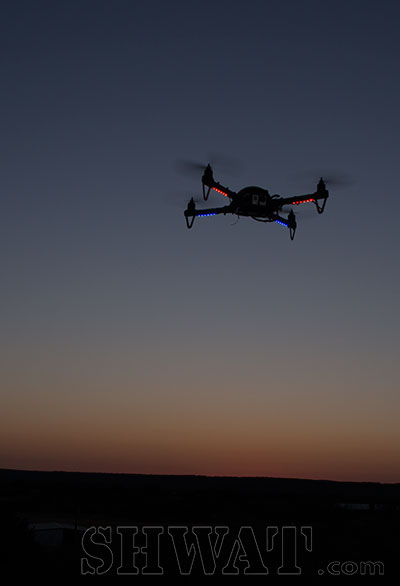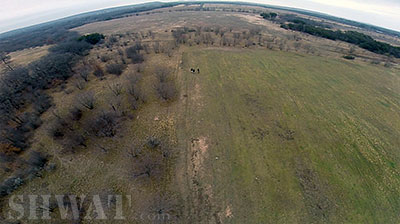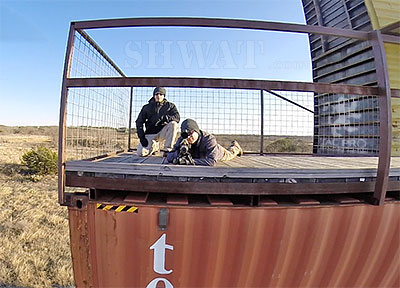 When it comes to hunting with drones, the only thing certain is that passions run hotter than in most other drone or UAV discussions. And some of those are pretty warm already. A variety of additional unique issues are on the table once you introduce UAVs (Unmanned Aerial Vehicles) into the hunting world. Questions of “fair chase”, safety, and even what constitutes hunting are all on the table. Just last week a Federal judge dismissed the Federal Aviation Administration’s jurisdictional claims over small drones flying under 400 feet, opening up all kinds of possibilities. With the unknowns and future in mind, we invited Darley Defense to bring their Stinger UAV to Tac Pro Shooting Center to explore the possibilities. What we discovered won’t answer all the questions, but will certainly put to rest some misconceptions about capabilities and options.
When it comes to hunting with drones, the only thing certain is that passions run hotter than in most other drone or UAV discussions. And some of those are pretty warm already. A variety of additional unique issues are on the table once you introduce UAVs (Unmanned Aerial Vehicles) into the hunting world. Questions of “fair chase”, safety, and even what constitutes hunting are all on the table. Just last week a Federal judge dismissed the Federal Aviation Administration’s jurisdictional claims over small drones flying under 400 feet, opening up all kinds of possibilities. With the unknowns and future in mind, we invited Darley Defense to bring their Stinger UAV to Tac Pro Shooting Center to explore the possibilities. What we discovered won’t answer all the questions, but will certainly put to rest some misconceptions about capabilities and options.
Let’s start with a little context. The “drone” word, or even “UAV” can conjure up scary thoughts of global strikes on terrorists or suspect privacy issues akin to NSA snooping. Reality check – Darley’s Go Pro and FLIR equipped Stinger costs about $20,000 and is not really very good for either of those purposes. Narrow that down to drone platforms in the few hundred to few thousand dollar consumer category, and capabilities for nefarious activities drop further. In this story, we’re going to look at the possibilities and limitations of what’s currently available here in the real world.
Since hands on use trumps theory, we were quite happy that Darley’s Mike Mocerino was available to spend a few days exploring Tac Pro Shooting Center with Tac Pro’s founder Bill Davison and us. Darley’s Stinger UAV was designed to serve fire fighters and other first responders. It has a six thousand dollar FLIR thermal camera for identifying hot spots on roof tops, keeping track of at risk personnel or fleeing suspects. Despite the price tag, the four rotor Stinger is far more economical and much faster to deploy than a traditional helicopter. Mocerino could literally have the Stinger airborne in two minutes from the time he opened up its Pelican Case. Since the Stinger’s thermal camera video feed can be transmitted to the ground in real time, this technology could be a literal lifesaver for Law Enforcement and Fire Fighters.
Let your imagination run with that for a moment and think about how getting real time thermal video from a drone could impact hunting down feral hogs while they are in the act of destroying land and crops. Micro heat seeking missiles aren’t really available to us civilians, so cross that off. Mounting guns is out on several legal fronts. Not only that, but the lift capability of most drones, even Darly’s $20,000 Stinger, stops at a Go Pro camera or two. Airborne guns would really mess up any semblance of sporting “fair chase” ethics.
 But is it fair to press “Fair chase” as part of tactical hog hunting?
But is it fair to press “Fair chase” as part of tactical hog hunting?
“Fair chase” essentially prioritizes giving game animals a fair shake in the hunting game. “What’s for dinner” was probably a bigger priority when we graduated from bows to muskets, to centerfire lever action rifles. Then we got serious rifle scopes and high powered calibers allowing the average hunter to identify and shoot game animals from much longer distances. I have no idea if the “is that fair to Bambi?” question was raised as those technological advancements hit the sport hunting community, but it sure makes me wonder…
For those living around or owning land ravaged by feral hogs, “hunting” wild pigs often means something more akin to “eradication” than “fair chase.” But, no one wants to eradicate deer, elk, and other “higher” game animals. For our purposes in Tactical Hog Hunting where wild hogs create an adverse impact, the idea of having a thermal eye in the sky seems inviting. And we’re not the only or the first to have that thought.
I contacted Cy Brown, known for his Dehogiflier drone videos on YouTube. Brown’s drone is a fixed wing model, more akin to a radio controlled airplane. It gives him longer flight times than what consumer multi rotor helicopter style drones can. In the tall grass of Louisiana, hogs can be difficult to spot when on foot. Day or night, thermal scope or otherwise, they can disappear into the grass. Last year Brown had three people including himself trip over hogs at night. Using the Dehogiflier’s thermal camera as their eye-in-the-sky, Brown and the hunters with him are both safer and more effective in their quest to kill invasive destructive feral hogs. And film the process.
The limitations for hunters, however, are quite real. There are both legal and practical limitations, none of which impacted our ability to create some goofy footage with Moecerino’s help. On the practical side of hunting with drones, the things make noise. The more rotors, the more noise. At 100 feet of altitude and 100 yards south, the wildlife at Tac Pro spooked. That doesn’t help you hunting at all.
 You can’t tell a drone to go find and track pigs for you. That takes a pilot, and if you are hunting with me, I’d rather you fly and I shoot. The question is, can you pilot the thing? It’s one thing to fly around your in your house with a $30 toy from the mall, but quite another to fly even a $1000 investment in the wind and elements. Spend enough dollars and you can use GPS to create autonomous flight by way points. You still might need to manually take over for safety reasons. If you just want to film your hunt for fun, that’s doable with a Go Pro, but you’re not going to get anything resembling Hollywood that way.
You can’t tell a drone to go find and track pigs for you. That takes a pilot, and if you are hunting with me, I’d rather you fly and I shoot. The question is, can you pilot the thing? It’s one thing to fly around your in your house with a $30 toy from the mall, but quite another to fly even a $1000 investment in the wind and elements. Spend enough dollars and you can use GPS to create autonomous flight by way points. You still might need to manually take over for safety reasons. If you just want to film your hunt for fun, that’s doable with a Go Pro, but you’re not going to get anything resembling Hollywood that way.
The legal limitations are on the one hand simple, on the other, nuanced and gray. The FAA has appealed the new ruling that booted them from low altitude drone oversight, and claim the appeal stays the ruling. If true, general rules are similar to old school remote control aircraft, though the technology to flaunt those rules is available and not really cost prohibitive. For example, fly under 400 feet. If a drone will fly 400 feet up, it’s probably cable of a lot more. Operate by visual contact, meaning you have to keep your eye on your drone, which presumes it’s not flying out of sight. But you can easily get enough radio range and a first person view (FPV) device to outfly that distance. Stay away from airports and schools. And don’t fly for money. No commercial operations allowed. Yes, we know all kinds of people flaunt that, or skirt that with some plausible sidestep. The gray areas are real, but people are taking their chances.
Where does this leave us? Well, while a drone/UAV probably won’t be your next hunting buddy, drones will become more prevalent in all walks of life. Technology has given us all kinds of advancements hunters use today from rifles and ammo to red dot sights and thermal scopes. It’s anyone’s guess whether the FAA rules due out in the next 12-18 months will increase or decrease restrictions and opportunity. Here at SHWAT™, we intend to keep asking the questions and keep you informed. We might even make some videos…

